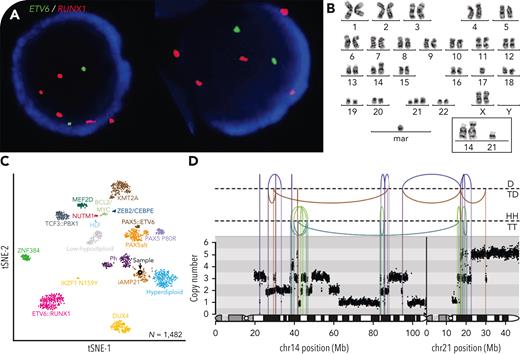A 6-year-old girl was diagnosed with B-lineage acute lymphoblastic leukemia (B-ALL), with classic morphology and immunophenotype. Fluorescence in situ hybridization detected 4 to 5 RUNX1 signals in 48% of cells (panel A; RUNX1, red signals; ETV6, green signals; 100× objective), classifying her as having B-ALL with intrachromosomal amplification of chromosome 21 (iAMP21-ALL). Leukemic karyotype, 48,XX,der(14;21)(q10;q10),+add(21)(p11.2)×2,+mar[5] (panel B; 100× objective), showed abnormal chromosome 21 and 1 abnormal chromosome 14, evolved from a constitutional Robertsonian translocation between chromosomes 14 and 21, rob(14;21)c (panel B; inset). Whole transcriptome sequencing showed the same gene expression profile as other iAMP21-ALL cases (panel C; t-distributed stochastic neighbor embedding [t-SNE] plot). Whole-genome sequencing detected oscillating copy numbers and structural rearrangements between chromosomes 14 and 21 (panel D), similar to those reported in rob(15;21)c carriers.
Constitutional Robertsonian translocations occur in ∼1 in 800 people in the general population. Among those involving chromosome 21, rob(14;21)c is the most common, accounting for 15% to 20% of Robertsonian translocations, whereas rob(15;21)c is scarce (<1%). Despite their rarity, rob(15;21)c carriers have 2700× increased risk of developing iAMP21-ALL, involving the rob(15;21)c chromosome. In contrast, to our knowledge, this is the only case recorded involving a rob(14;21)c Robertsonian chromosome among >700 known cases of iAMP21-ALL. These observations highlight the extreme heterogeneity of iAMP21-chromosome morphology in iAMP21-ALL.
For additional images, visit the ASH Image Bank, a reference and teaching tool that is continually updated with new atlas and case study images. For more information, visit https://imagebank.hematology.org.


This feature is available to Subscribers Only
Sign In or Create an Account Close Modal